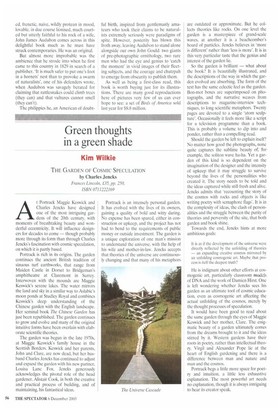Green thoughts in a green shade
Kim Wilkie
THE GARDEN OF COSMIC SPECULATION by Charles Jencks Frances Lincoln, £35, pp. 256, ISBN 0711222169 At Portrack Maggie Keswick and Charles Jencks have designed one of the most intriguing gardens of the 20th century, with moments of breathtaking beauty and wonderful eccentricity. It will influence designers for decades to come — though probably more through its form than through Charles Jencks's fascination with cosmic speculation, on which it is partly based.
Portrack is rich in its origins. The garden continues the ancient British tradition of sinuous turf earthworks, that range from Maiden Castle in Dorset to Bridgeman's amphitheatre at Claremont in Surrey. Interwoven with the mounds are Maggie Keswick's serene lakes. The water mirrors the land and sky in a similar way to Aslabie's moon ponds at Studley Royal and combines Keswick's deep understanding of the Chinese garden with the English landscape. Her seminal book The Chinese Garden has just been republished. The garden continues to grow and evolve and many of the original intuitive forms have been overlain with elaborate scientific theories.
The garden was begun in the late 1970s, at Maggie Keswick's family house in the Scottish Borders. Keswick and her parents, John and Clare, are now dead, but her husband Charles Jencks has continued to adjust and expand the garden with his new partner, Louisa Lane Fox. Jencks generously acknowledges the pivotal role of the head gardener. Alistair Cook, in both the creative and practical process of building, and of maintaining, his fantastical ideas. Portrack is an intensely personal garden. It has evolved with the lives of its owners, gaining a quality of bold and witty daring. No expense has been spared, either in construction or upkeep, and the project has not had to bend to the requirements of public money or outside investment. The garden is a unique exploration of one man's mission to understand the universe, with the help of his wife and mother-in-law. Jencks accepts that theories of the universe are continuously changing and that many of his metaphors are outdated or approximate. But he collects theories like rocks. On one level the garden is a masterpiece of grand-scale waves, at another it is a beachcomber's hoard of particles. Jencks believes in 'more is different' rather than less is more'. It is in this very particular taste that the genius and interest of the garden lie.
So the garden is brilliant — what about the book? It is beautifully illustrated, and the descriptions of the way in which the garden evolved are absorbing. The form of the text has the same eclectic feel as the garden. Bon-mot boxes are superimposed on photographs, and the narrative weaves from descriptions to magazine-interview techniques, to long scientific metaphors. Twenty pages are devoted to a single 'atom sculpture'. Occasionally it feels more like a script for a television programme than a book. This is probably a volume to dip into and ponder, rather than a compelling read.
Should the garden be left to explain itself? No matter how good the photographs, none quite captures the sublime beauty of, for example, the soliton wave ha-ha. Yet a garden of this kind is so dependent on the imagination of the designer and the intensity of upkeep that it may struggle to survive beyond the lives of the personalities who created it. The story needs to be told and the ideas captured while still fresh and alive. Jencks admits that 'recounting the story of the cosmos with rocks and objects is like writing poetry with semaphore flags'. It is in the complexity of ideas, the clash of personalities and the struggle between the purity of theories and perversity of the site, that both garden and book shine.
Towards the end, Jencks hints at more ambitious goals:
It is as if the development of the universe were directly reflected by the unfolding of theories — an expanding creative cosmos mirrored by an unfolding cosmogenic art. Maybe, that process is itelf the deepest truth?
He is indignant about other efforts at cosmogenic art, particularly classroom fnedell of DNA and the work of Damien Hirst. One is left wondering whether Jencks sees his garden as an ultimate tool of cosmic education, even as cosmogenic art affecting the actual unfolding of the cosmos, merely by the thought processes of speculation.
It would have been good to read about the same garden through the eyes of Maggie Keswick and her mother, Clare. The enigmatic beauty of a garden ultimately comes from the dreams brought to it and the ideas stirred by it. Western gardens have their roots in poetry, rather than intellectual theory. Virgil and Alexander Pope lie at the heart of English gardening and there is a difference between man and nature and man and the cosmos.
Portrack begs a little more space for poetry and intuition, a little less exhaustive explanation. The most powerful art needs no explanation, though it is always intriguing to hear its creator speak.


























































































 Previous page
Previous page